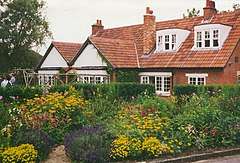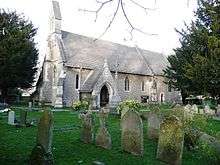Headington Quarry
Headington Quarry is a residential district of Oxford, England, located east of Headington and west of Risinghurst, just inside the Oxford ring road in the east of the city. To the south is Wood Farm. Today the district is also known colloquially as "Quarry".[1] The area, now residential, is considerably uneven due to previous quarrying in the area.
Headington Quarry
| |
|---|---|
 The Kilns, where the author C. S. Lewis lived | |
 Headington Quarry Location within Oxfordshire | |
| OS grid reference | SP553070 |
| District | |
| Shire county | |
| Region | |
| Country | England |
| Sovereign state | United Kingdom |
| Post town | Oxford |
| Postcode district | OX3 |
| Dialling code | 01865 |
| Police | Thames Valley |
| Fire | Oxfordshire |
| Ambulance | South Central |
| UK Parliament | |
The Church of England parish church of the Holy Trinity[2][3] was designed by George Gilbert Scott and built in 1848–49.[4] The east window of its chancel was designed by Ninian Comper.[4] The Friends of Holy Trinity Church was founded in 2002 to raise funds and look after the church.[5] In 1930, C. S. Lewis, Oxford academic and author of The Chronicles of Narnia, and his brother Warnie moved, with Mrs Janie Moore and her daughter Maureen, into "The Kilns", a house on the outskirts of Headington Quarry.[6] Lewis attended Holy Trinity Church.[7] He first preached there on 29 March 1942, on the subject of "Religion and pleasure", and he is buried in the churchyard.
There is a former Methodist Chapel in Quarry High Street.[8] The Headington Quarry Morris Dancers are based in the area.[9] Headington Quarry Morris Dancers were the first Morris dancers ever seen by Cecil Sharp, on Boxing Day 1899.[10] This chance meeting was one of the events that sparked a lifelong interest in folk dance, song and music, to which Sharp devoted much of his life.
Headington Quarry was designated a conservation area[11] in 1971, and the Friends of Quarry[12] is a residents' association which aims to preserve the distinctive character of the Conservation Area and its immediate neighbourhood.
Other features
Geographically central to the Quarry, the original school, variously named Headington Quarry National School, Headington Quarry Church of England Junior Mixed School, and Headington Quarry Church of England First School, was closed in 2003 due to a lack of enrolments.[13] The school building was originally built in 1864. The school is now home to the Headington Quarry Foundation Stage School. The school building is conservation listed.[14]
Headington Quarry is noted for its array of narrow, winding roads and alleyways; for the undulating terrain on which houses have been built as a result of the quarrying that took place; and for the significant amount of greenspace in the area.
Headington stone
Headington Quarry had a number of stone quarries.[15] Headington stone, a style of limestone, was traditionally used for some Oxford University college buildings, although it was prone to erosion by pollution.[16] In 1396, stone from quarrying in Headington was used to build the bell-tower for New College. Headington stone was also used in the 1520s by Cardinal Wolsey to build his Cardinal College (now Christ Church).
References
- Headington Quarry, Oxford City Council.
- Holy Trinity Church, Headington Quarry
- SP5506: Holy Trinity Church, Headington Quarry, Geograph
- Sherwood & Pevsner, 1974, page 337
- About Us Archived 10 July 2009 at the Wayback Machine, Friends of Holy Trinity Church, Headington Quarry.
- Headington History: The Kilns, Lewis Close, Risinghurst
- Headington History: C.S. Lewis and Headington
- Headington History: Former Methodist Chapel, Quarry High Street, Headington
- The Headington Quarry Morris Dancers
- Oxfordshire Blue Plaques: William Kimber
- More information about the Headington Quarry Conservation Area on city council website
- Friends of Quarry website
- Stephanie Jenkins. "Headington Quarry School". Retrieved 20 November 2013.
- "Headington Quarry Conservation Appraisal" (PDF). Oxford City Council. Archived from the original (PDF) on 14 November 2012. Retrieved 20 November 2013.
- "Headington History: The Stone Quarries of Headington". Archived from the original on 10 July 2009. Retrieved 3 September 2009.
- Viles, Heather. "Crumbling facades: Past, present and future threats to Oxford's stonework" (PDF). University of Oxford. Retrieved 4 April 2010.
Sources
- Sherwood, Jennifer; Pevsner, Nikolaus (1974). The Buildings of England: Oxfordshire. Harmondsworth: Penguin Books. p. 337. ISBN 0-14-071045-0.

